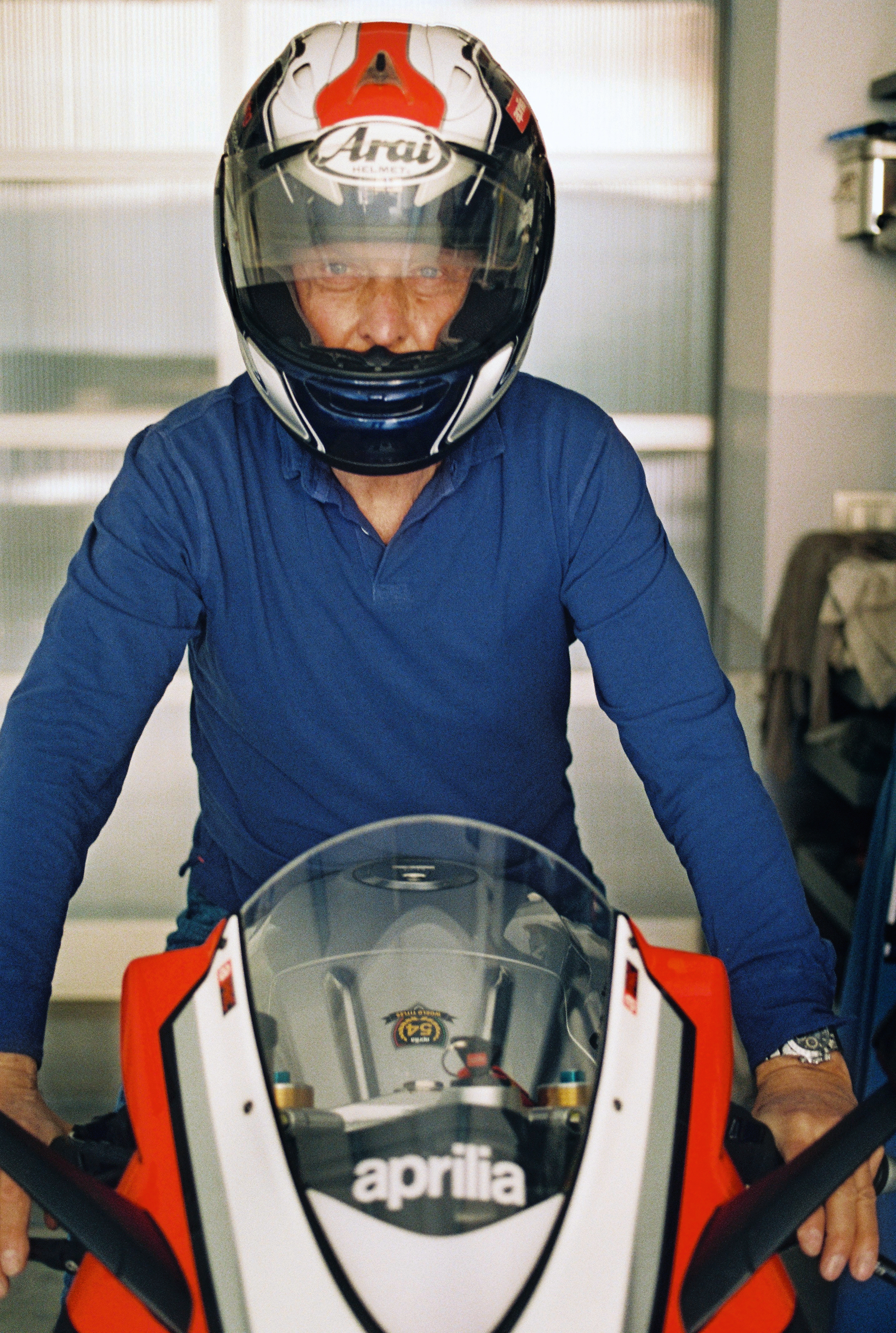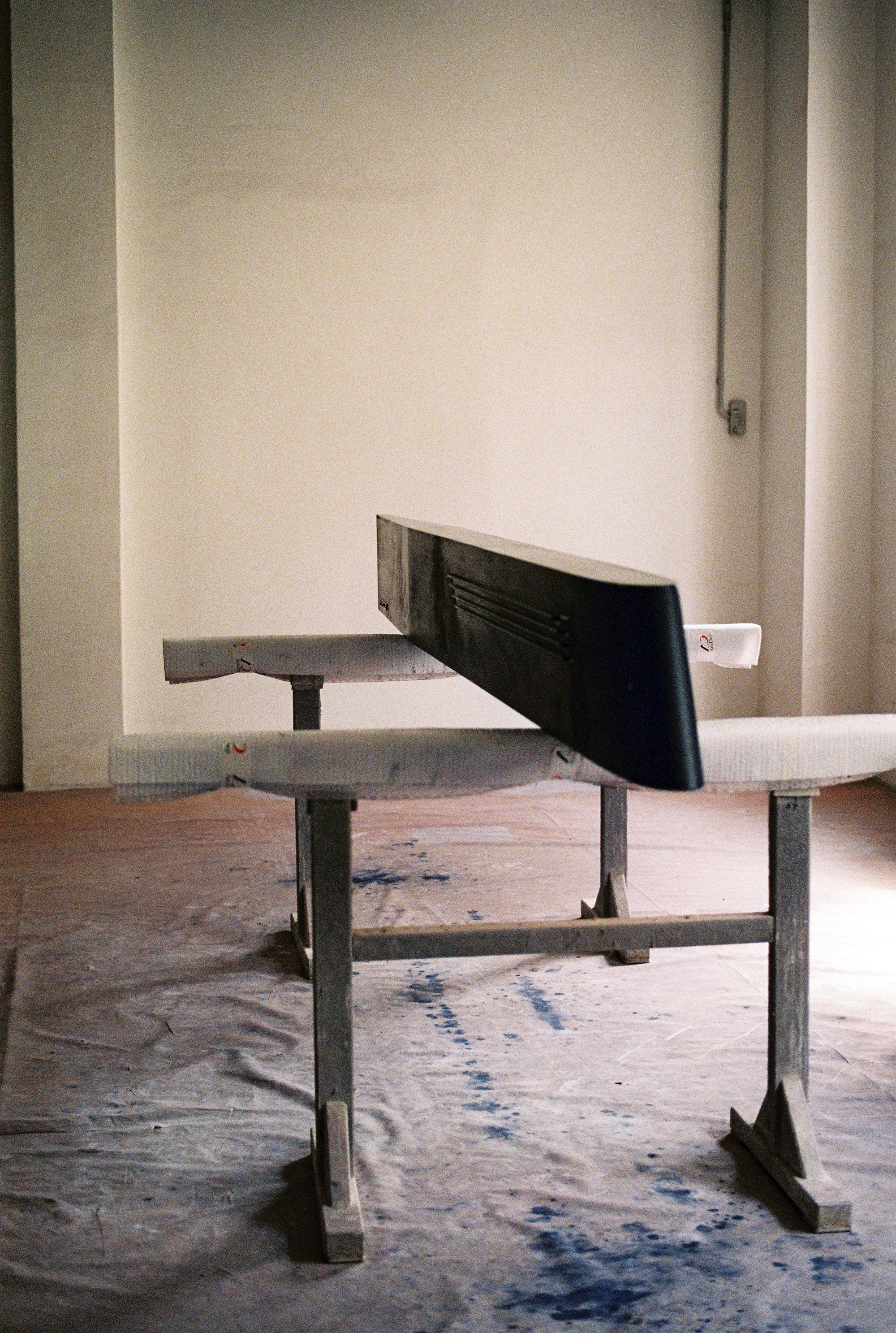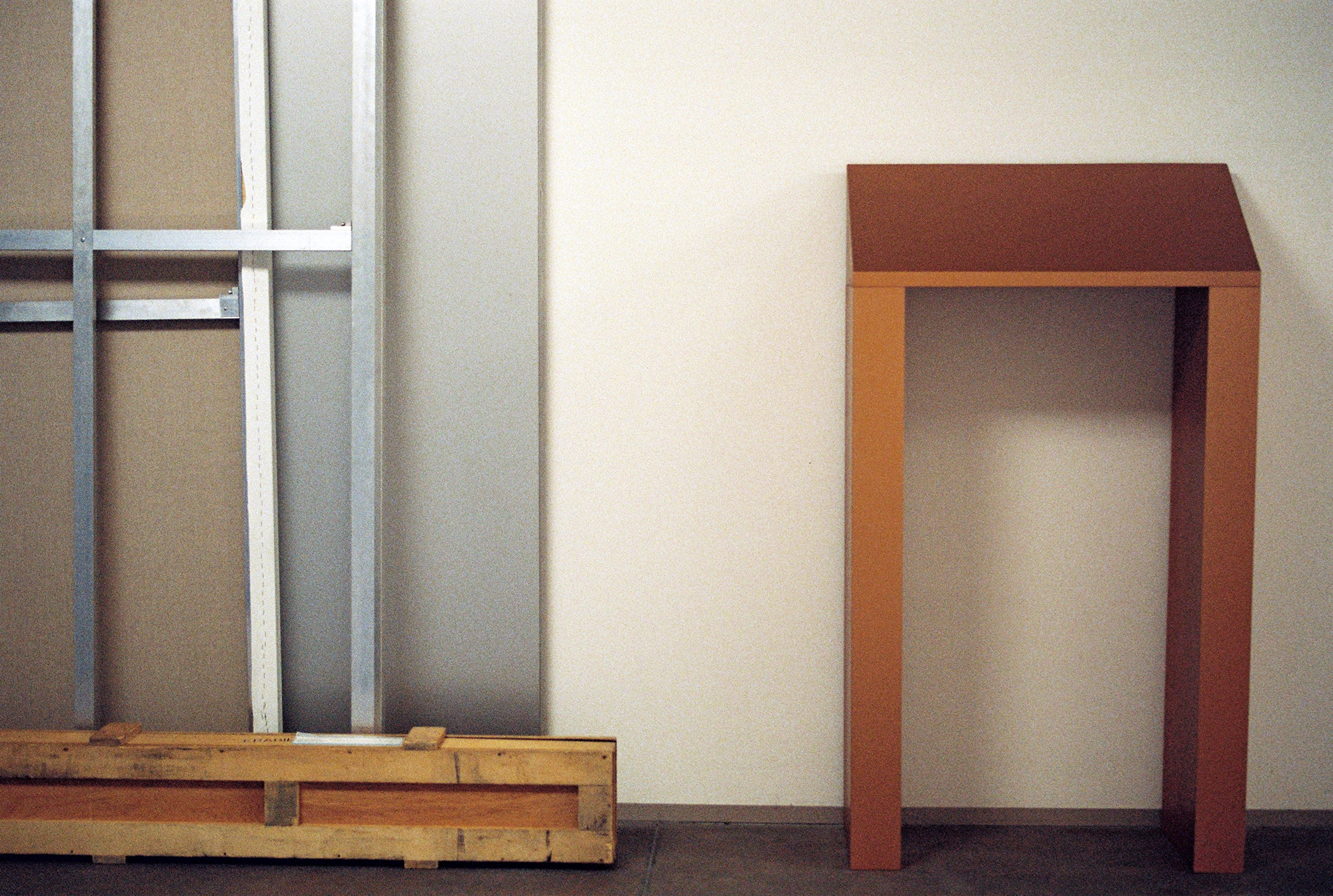Purple Magazine
— F/W 2016 issue 26
Gianni Piacentino
interview by MAURIZIO CATTELAN in collaboration with MARTA PAPINI
photography by GIASCO BERTOLI
Italian artist Gianni Piacentino (b. 1945), under the radar for decades, has led a double life as an artist — he was an early member of Italy’s Arte Povera movement — and as a motorcycle racer. In his home in Turin, he constructed a contemporary vision of Futurism, combining Pop Art, Minimalism, technical precision, and an intuition about speed, art, and design. Thanks to the Fondazione Prada in Milan, we discover this incredible artist.
MAURIZIO CATTELAN — How did you start making art? Have your motivations remained the same, or have they changed over time?
GIANNI PIACENTINO — I was really good at drawing as a kid. In elementary school and middle school, I was faster and more skilled than my teachers. I loved the display windows of art shops. I read manuals on painting techniques, from Giorgio Vasari to Giorgio de Chirico. When I was 13 or 14, I discovered modern art. I saw artworks by Paul Klee for the first time and made him my ideal maestro. I carefully studied his “theory of form and figurative representation” [Klee’s lessons
at the Bauhaus]. When I was 15, I began creating my first paintings, preparing canvases by myself. My motivation was to become an artist. Later on, you start to measure yourself against your contemporaries and the history of art.
MAURIZIO CATTELAN — Turin is undoubtedly a city that has an effect on people. You studied there. Do you think the atmosphere in Turin during the first half of the 1960s influenced your work?
GIANNI PIACENTINO — I’m sure every place exerts an influence, although I’ve always been resistant to their effects. But there’s no doubt that the things Luciano Pistoi exhibited at the Centro di Ricerche Estetiche [Center of Aesthetic Research] at the beginning of the 1960s were important for me, just as Lichtenstein’s exhibition at Galleria Il Punto Arte Moderna was. But back then, only very few people were interesting in modern art, what they called the “avant-garde.”
MAURIZIO CATTELAN — Back then, I imagine the presence and activity of factories in the city were felt at every level, while your work was immediately based on the craftsmanship of the process. Are there any points of contact between the world of industrial production and that of the works you create?GIANNI PIACENTINO — There has always been a high level of technical craftsmanship that could compete with the “factory” in terms of quality. My early sculptures required the help of talented carpenters. In order to build them in the best way possible, I followed the advice of Sottsass’s modeler at Olivetti.
MAURIZIO CATTELAN — What was the most important piece of advice you received?
GIANNI PIACENTINO — To build my poles and square section structures not out of solid wood — usually made up of two pieces of mirroring Obeche wood glued together — but rather as “boxes” made of plywood with corners cut and glued together at 45-degree angles. This allowed them to resist tiny movements of the wood over time without showing any signs of shifting. But when it came to paints, I was already way ahead of my time, following industrial uses more than handicraft.
MAURIZIO CATTELAN — Have you ever had the feeling that Turin has been orphaned twice, first by the monarchy and then by Fiat?
GIANNI PIACENTINO — Let’s say twice liberated.
MAURIZIO CATTELAN — I heard that in 1967 you worked as a DJ at the Piper Club. Do you remember which albums you put on the turntable?
GIANNI PIACENTINO — Back then, being a DJ wasn’t like it is today. You had to play the presenter, maintain relationships with bands and singers, and take charge of the sound system from a technical point of view. But in any case, I played more Rolling Stones than Beatles. I remember playing Cream, The Who, Led Zeppelin, Jimi Hendrix, John Mayall & the Bluesbreakers, The Doors, Otis Redding, Bob Dylan, Deep Purple, Pink Floyd…
MAURIZIO CATTELAN — In 1965 in Milan, Lucio Fontana had a studio in Corso Monforte. How did you two meet? Do you think he influenced your work in any way? Did your work influence his?
GIANNI PIACENTINO — I met Fontana, and in 1967 he bought an artwork during my exhibition at Galleria Sperone in Milan. Honestly, I don’t know if there was any influence. He seemed like he was from another generation, unlike Piero Manzoni and Francesco Lo Savio, who seemed a lot closer to me. I certainly don’t think my work influenced his in any way. Back then, I was making large-scale sculpture — the largest I could, given the space available in my studio — and he was doing his teatrini [little theaters], which I think are quite undervalued.
MAURIZIO CATTELAN — Are there other artists you’ve been in contact with in the past? What about today? Do you believe exchange between artists is relevant for your work?
GIANNI PIACENTINO — I often met with Giulio Paolini in 1964 and 1965, as well as with Michelangelo Pistoletto during the next two years, in 1966 and 1967. Today, no… I sometimes talk to Maurizio Mochetti because we share some interests, like motors and motorsports. Already in the 1970s, there was more competition than open exchange. Back then, at least, it was easier to distinguish the original from an intelligently disguised copy.
MAURIZIO CATTELAN — Are there any artists you feel are valid among those who are emerging today?GIANNI PIACENTINO — I have to admit that starting at the end of the 1960s, I was no longer particularly interested in contemporary art,so I don’t know it well enough to make a reasonable judgment. To me, it all seems too homologous and plagiarized. But I’m always ready to change my mind.
MAURIZIO CATTELAN — What kind of relationship did you have with Arte Povera?
GIANNI PIACENTINO — The show that prefigured Arte Povera was “Arte Abitabile,” held at Sperone in 1966 [Piero Gilardi, Piacentino, Pistoletto]. Then it drew in all the artists orbiting the Sperone gallery, united by no precise idea if not that of creating a new, less academic art. Germano Celant had the sensibilities and intelligence to recognize what was going on and define a theory for it. I took part in all the Arte Povera exhibitions up until 1968.
MAURIZIO CATTELAN — Then what happened?
GIANNI PIACENTINO — As the work developed, distances increased. As many have written, in 1968 at the Deposito d’Arte Presente in Turin — a large space run by an enlightened collector [Marcello Levi] and Sperone — each of us exhibited two or three artworks together. Mine were much larger than the others… In the beginning, Arte Povera artworks were not so big in size. So they moved mine, without telling me, to the back of the space. Effectively mine were cutting nearby works off from view. After that happened two or three times, I grew tired of it, pulled my artworks from the show, and left the Sperone gallery and the entire group behind. There were other things I didn’t like, too… Sperone insisted on knowing everything about the projects and giving advice on how and whether or not to realize them. Everybody else seemed to be okay with this,
but I wasn’t.
MAURIZIO CATTELAN — Where did your passion for speed originate? Do you think it has any conceptual connections with Futurism?
GIANNI PIACENTINO — It started later on, around when I was 21 or 22. But I was interested in real, actual speed, not the representation of speed. To be honest, I’ve never really liked Futurist paintings, except for a few by Giacomo Balla and Umberto Boccioni.
MAURIZIO CATTELAN — If you had to coin a term to define your art, what word would you use?
GIANNI PIACENTINO — I don’t like words connected to art, but art that is defined through the works.
MAURIZIO CATTELAN — What was the first motorcycle you rode? How did you move around in the highly competitive world of sidecar racing? Do you still race motorcycles today?
GIANNI PIACENTINO — My first was a Moto Guzzi V7 700 cc, in 1968. I’d already restored a 1938 Indian 600, which was beautiful but practically impossible to drive. In the world of racing, in addition to being a sidecar passenger I was an expert on decorating and painting motorcycles and helmets. Of course it’s a world that — as long as you survive it — gives you extraordinary strength. It’s a grand behavioral school. If you make a mistake in racing, you pay for it by being injured or killed, not like in art, where you can just change and try something else. When I had my first exhibition in New York [at the gallery O.K. Harris in 1971], the gallery owner talked to me about the extremely harsh competition among artists, and that made me laugh. As soon as I showed him some photographs of my sidecar races, he understood.
MAURIZIO CATTELAN — You transformed your initials into a logo used on all your artworks. Do you consider it as an artist’s signature, or more as a trademark?
GIANNI PIACENTINO — I’ve been bothered by signatures on artworks ever since I was a kid. They don’t have anything to do with the language of a painting. Obviously I got that idea from the industrial world, where logos are harmoniously inserted into the decoration of the objects produced.
MAURIZIO CATTELAN — You were living in New York City at the beginning of the 1980s. What memories do you have of that period? Do you find the city has changed a great deal today?
GIANNI PIACENTINO — I remember how disappointed I was with the New York art scene. That was when painting styles that combined a few remnants of New York garbage were formed — for example, the Transavantgarde school. I’d never been interested in that kind of painting. I remember a wonderful exhibition of Robert Motherwell uptown.
I went to the Bronx to buy special colors. I got custom-sized stretchers built for me in New Mexico. Of course, today the city has changed for the better in terms of safety, but for the worse in terms of the ghettoization of the wealthy in certain neighborhoods that used to be a lot more alive.
MAURIZIO CATTELAN — Do you keep a regular schedule when you work? Have you ever found yourself unsure about what the next project would be?
GIANNI PIACENTINO — Absolutely. Without a disciplined process, you can’t get anything done. Starting from the first project design — I used to do them on graph paper notebooks, but now I do them with a computer — I move to verifying the buildability, and this stage can require modifying some details, then on to construction in specialized workshops and finishing the work, which often requires multiple phases and which I do myself personally. Over the past few years, between new works and the restoration of older, damaged works, I haven’t had a moment’s rest.
MAURIZIO CATTELAN — Are you directly involved in the physical realization of your artworks?
GIANNI PIACENTINO — Yes. I’m an expert professional painter and polisher of metals.
MAURIZIO CATTELAN — In many interviews, you’ve confessed that you are particularly lucky with women. What’s your secret?
GIANNI PIACENTINO — At my age, it seems ridiculous to talk about such things. Naturally I had the good fortune to live through the 1960s and 1970s, when the women’s lib movement was booming.
MAURIZIO CATTELAN — Do you have a favorite place in Turin?
GIANNI PIACENTINO — Maybe my studio-house in Turin. It’s full of work and play: motorcycles, stamps, little models. I certainly love the roads I’ve been riding every Saturday on my extremely fast motorcycles. Right now I’ve got an Aprilia RSV4 1000 cc, 202 HP.
MAURIZIO CATTELAN — Do you follow the MotoGP?
GIANNI PIACENTINO — Of course. I subscribe to Dorna’s streaming website, so I see all the monitors with progressive time splits, which are the same ones they see in the pits. I get to listen to comments from very competent English announcers and not those of the Italian commentators, who show their support for the pilots too much.
MAURIZIO CATTELAN — With your recent retrospective at the Centre d’Art Contemporain in Geneva and at Fondazione Prada in Milan, your artwork seems to be seen in a new light. Have you become fashionable? Does this change anything in your work?
GIANNI PIACENTINO — There’s undoubtedly been more general attention, but I don’t think I’ve become fashionable. All this has certainly driven me to do new and — for some people — unexpected things, just as has always happened whenever things go well for me.
MAURIZIO CATTELAN — Has anyone ever proposed installing your work in a public space?
GIANNI PIACENTINO — Only for two temporary exhibitions that were organized by ABO, and for two private projects. But they were never realized. In any case, it’s extremely difficult for contemporary art to work as a monument — not even Picasso and Calder in Manhattan. I think it’s always missing a reference to the genius loci, to historical and social roots and the sizes of surrounding buildings. Maybe some architects could pull it off.
MAURIZIO CATTELAN — Looking back today, do you see something you’d have done differently? Do you have any words of wisdom to share?
GIANNI PIACENTINO — I’d say I don’t. In fact, sometimes I regret the stances I’ve taken in the past against gallery owners and various powerful people when I was younger, with behavior contrary to my convenience but not to my independence, including my refusal to participate in some important exhibitions. But the pleasure of saying “no” is still quite attractive. Advice? Whenever they say, “Take it or leave it,” always leave it.
MAURIZIO CATTELAN — What did you dream of becoming when you were a child? Have you managed to do it?
GIANNI PIACENTINO — As far back as I can remember, more than dreams I had projects and hopes that I would realize them. For example, I didn’t dream of becoming a famous soccer player, but of owning my own soccer boots and uniform. I didn’t dream of being a famous racer, but of owning a splendid racing bike. I didn’t dream of becoming a great artist, but of having a lot of oil colors and paintbrushes. I’ve always loved the tools of my passions more than my own role as a protagonist in them. Today, I have a lot more than I ever desired.
END








































































































































